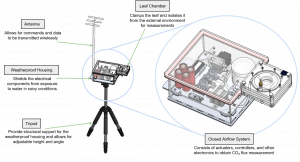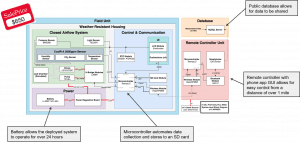Carbon Dioxide Sensor (On Hold)
Environmental Stewardship & Social Justice
Background
With increasing concern for climate change and the environment, analysis of water and CO2 exchange in plants is needed to assist sustainable land planning. Plants play a key role in regulating the carbon dioxide content of the Earth’s atmosphere, and with the destruction of natural habitats for resources and urban development, finding sustainable options to replant can help urban, drought and fire affected areas reduce their carbon footprint and water consumption.
Plants use two primary functions to produce and store energy: photosynthesis and respiration. Photosynthesis describes the chemical reaction in plants that converts CO2, water, and sunlight into glucose and oxygen,
6CO2 + 6H2O = C6H12O6 +6 O2,
and respiration describes the conversion of glucose and oxygen into CO2, water, and energy in the absence of light,
C6H12O6 + 6O2 = 6CO2 + 6H2O.
Transpiration describes the exchange of water between the plant and the air around it during photosynthesis and respiration. Water is carried from the roots to the leaves during photosynthesis, and then released through the leaves during respiration.
Unfortunately, existing CO2 measurement systems for analyzing the photosynthetic CO2 exchange, respiration and transpiration of plants often cost over $10,000 dollars and require manual data collection, proving costly and inefficient.
Goals and Design
We hope to create an affordable system for under $200 that can be used to capture a leaf's respiratory rates in situ. Our goal for making this measurement chamber accessible to all is to facilitate the creation of a plant library that identifies the effects of climate and environment change on transpiration in plants around the world. Ideally, we could also use this data to identify optimal plants for carbon sequestration for a given area.
Current systems cost thousands of dollars and are human operated; they cannot be left out in the field for repeated measurements. Our system will be automated to be viable in the field using Arduino or RasPi without compromising the quality of data, making this data more accessible and promoting sustainable land planning. We will develop this system using readily available components and make the design open source, so that anyone can build and improve upon our design.
Updates
Our preliminary prototype autonomously isolates the leaf to measure CO2, temperature, and relative humidity and is easy-to-use through a wireless interface and centralized database.
The housing is comprised of materials that do not affect the CO2 concentrations in the housing: PET, EPDM weather resistant, closed-cell foam gasket and was optimized this year through simulation to ensure non-stratified airflow. The next steps are to optimize the chamber design based on these simulations and optimize the automated fastening mechanism.
If we can successfully balance the cost and quality of data for our automated CO2 analysis system, we hope that scientists and environmental enthusiasts alike can access this data to promote a sustainable future. Ultimately we hope that this measurement system alongside the plant library will promote informed decision making about the plants we choose for CO2 uptake and water conservation.



